Where there’s a whale, there’s a way
Moby, my 10-year-old whale’s tongue agave (A. ovatifolia), which for 22 days has been sending a bloom stalk skyward, seems to be in transition. The stalk is now about 10 or 11 feet tall and holding.
Meanwhile, clusters of yellow flowers are emerging along the asparagus-shaped stalk.
The clustered flower buds on sturdy stems remind me of broccoli. Why is everything about Moby’s flowering so evocative of vegetables?
I can’t wait to see what it looks like when the spear-like tip unfolds. Will the flowers add another dozen feet in height, as shown in Shirley’s images of a flowering Agave ovatifolia a few years ago?
Moby’s bloom stalk doesn’t have much clearance left, not with live oak limbs only 12 feet up. Still, where there’s a whale, there’s a way. Perhaps Moby knows what he’s doing.
Many other succulents in my garden, like this trio of soap aloes (A. maculata), are sending up their own bloom stalks in solidarity. There’s also a tall, leaning ‘Chocolate Chips’ manfreda flower spike above the aloes’. Can you see it? And there’s Moby in the distance.
Here’s a better view from the other direction. The manfreda is growing in a container placed in the raised bed along the back of the house, so you walk under all those Dr. Seussian flowers as you pass by.
Honeybees love the aloe flowers and scooch right up those dangling coral tubes to collect pollen. Every time I walk by, I enjoy a close-up view of their work, which never worries me. They’re far too busy to bother with me.
Tall verbena (Verbena bonariensis) is flowering atop its own long stems, attracting butterflies.
I can’t overlook these shorter bloom spikes coming up on a potted aloe (at bottom) on the back steps. Purple oxalis (Oxalis triangularis), spikeless, is flowering with abandon too.
In the gravel garden out front, ‘Frazzle Dazzle’ dyckia (Dyckia choristaminea ‘Frazzle Dazzle’), a native of Brazil, has sent up multiple spikes of golden flowers. The deer usually find these and chomp them down, so I’m enjoying them while I can.
This is one of my favorite dyckias, totally hardy here in Austin’s zone 8b, drought tolerant, not lethally sharp like many dyckias, and with a cute, tribble-like appearance.
That’s my garden happenings! By the way, if you live in or near Austin, I hope you’ll make time to come see me at Hill Country Water Gardens tomorrow at noon for a short garden talk and booksigning afterward — part of the many happenings during the nursery’s Lily Blossom Festival. See News and Upcoming Events below for more details.
I welcome your comments. If you’re reading this in an email, click here to visit Digging and find the comment link at the end of each post.
_______________________
Digging Deeper: News and Upcoming Events
I’ll be speaking on April 30, noon-12:30 pm, in Cedar Park, Texas, at Hill Country Water Gardens & Nursery’s Lily Blossom Festival. My free talk is called “How to Garden Water-Wise, Not Water-Wasteful.” An old proverb reminds us that The frog does not drink up the pond in which he lives. Don’t be a water-guzzling frog! I’ll be sharing my tips for making a garden that is water-wise, not water-wasteful. Stick around after my talk for a book signing, with autographed copies of Lawn Gone! and The Water-Saving Garden available for purchase.
Come see me at Festival of Flowers in San Antonio, May 28, time TBA. Learn more about water-saving gardening during my presentation at San Antonio’s 19th annual Festival of Flowers. I’ll be at the book-signing table after the talk, with copies of both The Water-Saving Garden and Lawn Gone! available for purchase. Tickets to the all-day festival, which includes a plant sale and exchange, speakers, and a flower show, are available at the door: $6 adults; children under 10 free. Free parking.

All material © 2006-2016 by Pam Penick for Digging. Unauthorized reproduction prohibited.


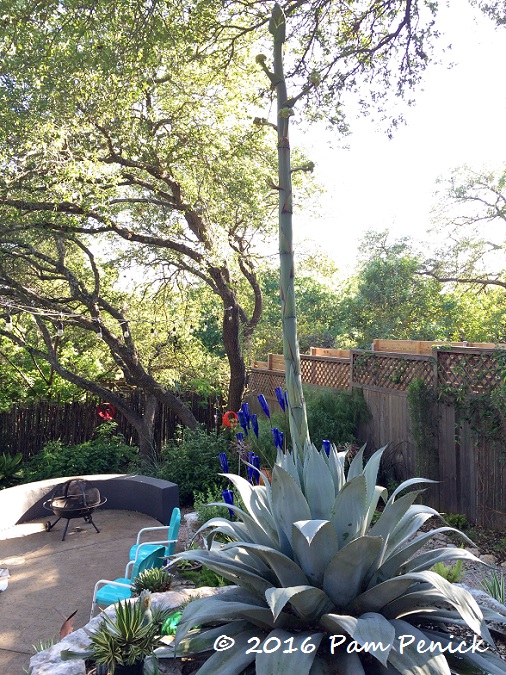
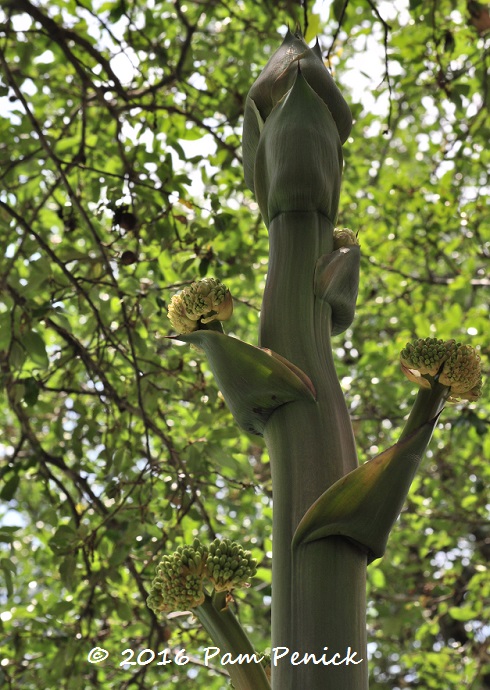
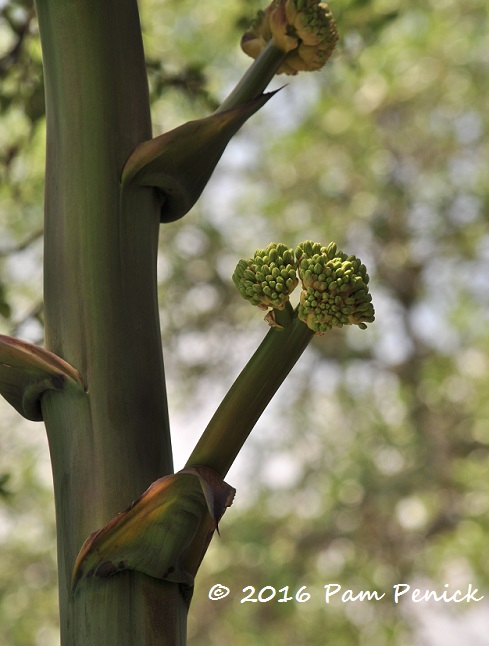
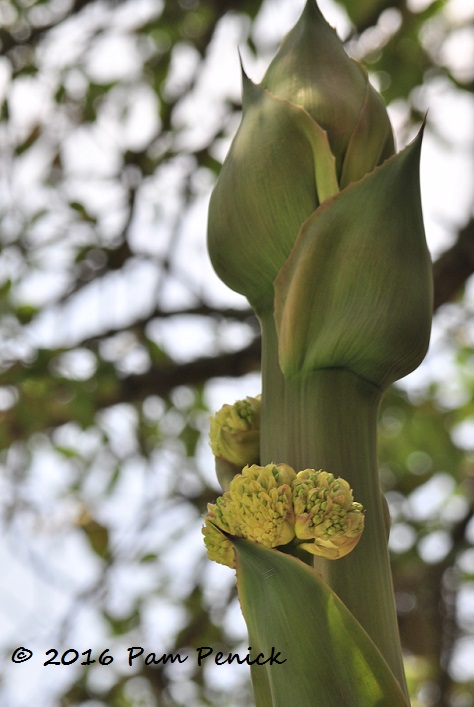
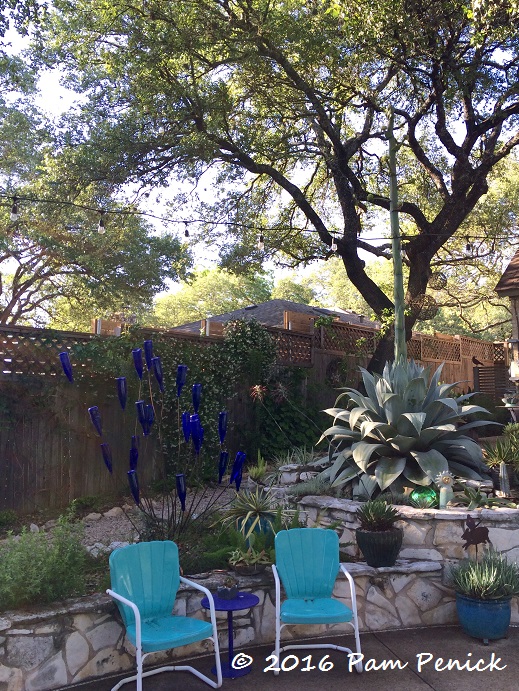
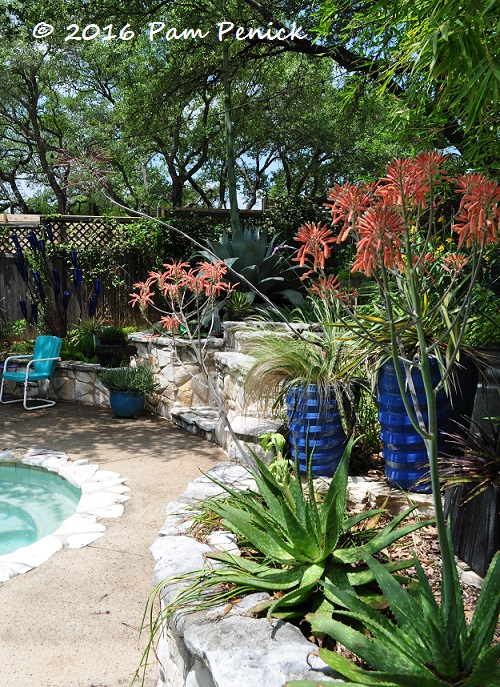
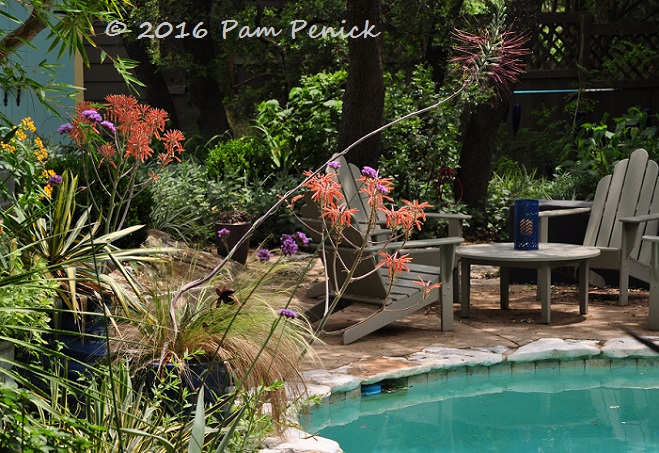
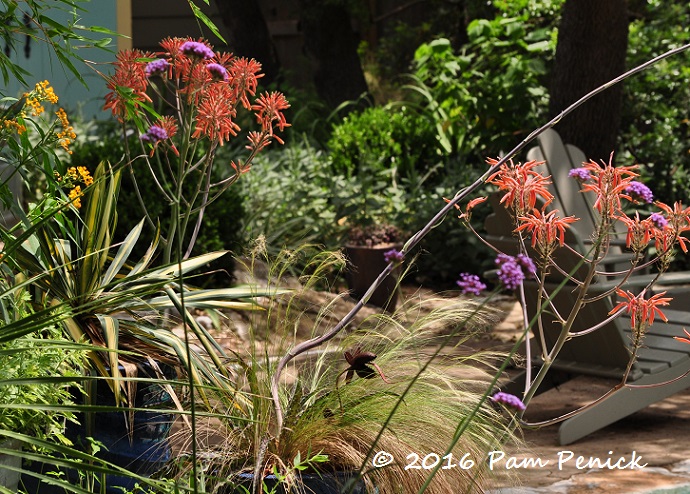
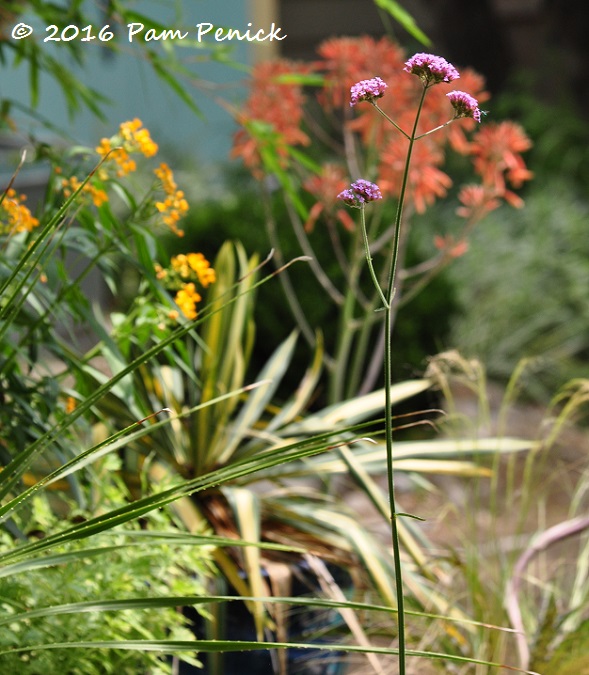
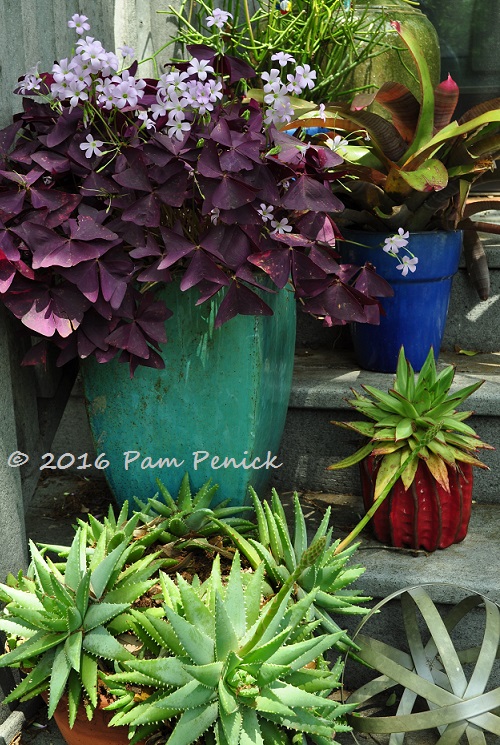
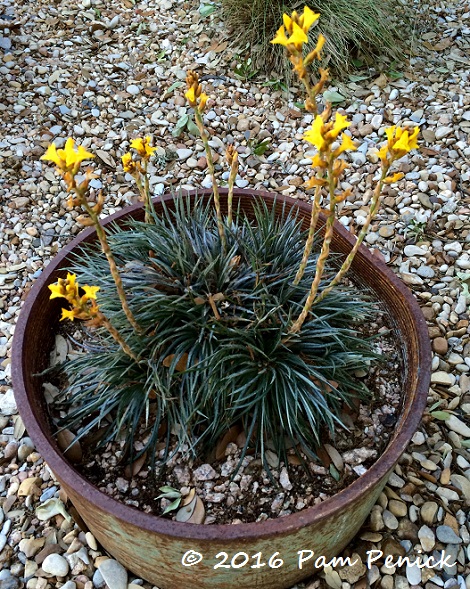
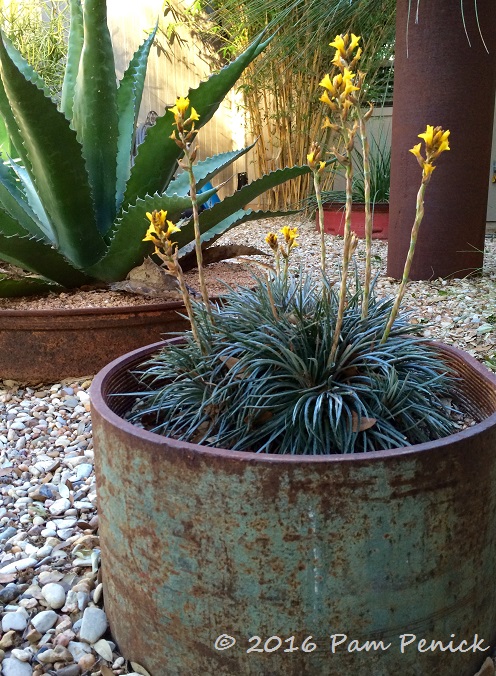
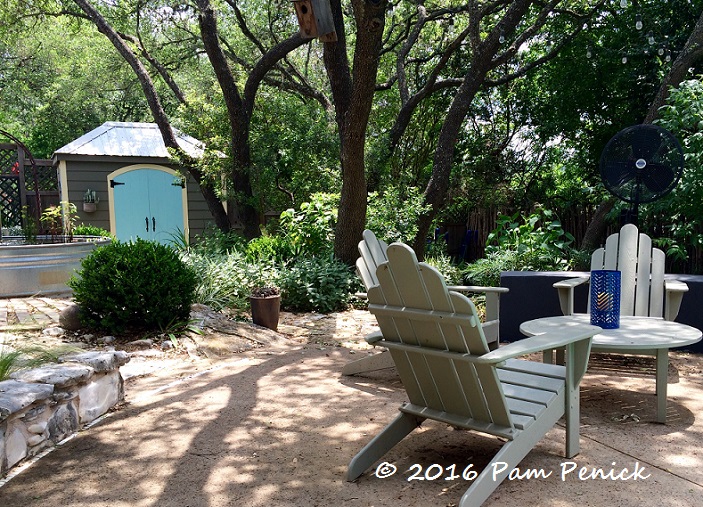
Gorgeous as usual! Re deer with the munchies, I find that Deer Out spray is quite effective. It has a minty smell, and so is pleasant to use. So maybe it would help preserve your tribbles’ floral display.
I should try that brand. I have a deer repellent spray that I use, but it stinks to high heaven. —Pam
Great blooms.
Moby’s progress has been really interesting. Thanks for keeping us posted.
Of course, Linda. Moby demands this kind of attention. He’s such a ham. —Pam
Tribble? I had to look that up. A Star Trek fan, right?
I’m afraid my geekiness is showing, Carol. —Pam
Like
And the very top of Moby’s stalk looks like an artichoke!
What IS it with this bloom stalk? Time for a salad. —Pam
I’m following Moby’s progress with great interest. It’s a blueprint for what I expect my whale’s tongue agaves will do in 3-4 years. Why can’t they be one of those species that don’t flower until they’re 20 or 30 years old?
But then we’d miss all the excitement, Gerhard. —Pam
Moby is impressive without the bloom stalk, with the bloom stalk he is out of this world. Amazing. I wonder if those flowers are edible at this stage? As you say they look like broccoli. I know the bugs and hummers will like them when they are open. Good lluck with all your talks.
Thanks, Lisa. I’ve never heard about agave flowers being edible, but perhaps that’s because they’re too high to reach. 😉 —Pam
Thanks for sharing Pam! A few years ago when I was still living in Austin, my century plant decided to bloom: it sent up a huge flower stalk, 23 ft high when in full bloom. The plant itself was 8 ft across and I named it “The Monster”. At Christmas time, I would hang very large ornaments on each tip that I could reach.
I love seeing agaves decorated at Christmas. It’s funny, and no doubt apt, that you named it The Monster. —Pam
Go Moby! Thank you for keeping us updated, his progress is astounding.
He’s been busy. —Pam
Moby is moving right along on that bloom. So many years to get there and then so fast. I’m glad I got to visit in person before he decided to bloom.
Thanks for the link!
I’m glad you did too, Shirley. I hope your own whale’s tongue gives you many more years before deciding to bloom. —Pam
BTW….your discussion of dry climate dyckias and such made me think of the email I got this week from Yucca Do. Better get another whale before they are gone for good.
These days I see whale’s tongues at most local nurseries. It is a shame about Yucca Do closing though. —Pam
Now I will forever associate that Dyckia with tribbles. How troublesome. 😉 My small specimen is just starting to send up a flower spike. I bring it in, either to the house or greenhouse, over winter. I know Loree has planted one in her garden, but mine is a little colder and I’m a little more timid.
The Trekkie reference may be troublesome, but this cute little dyckia will never be! I’m glad you have one to enjoy as well, Evan. —Pam
Moby has been a centerpiece of your garden(s) as long as I’ve been following you. His last act is hard to beat. I look forward to seeing what you have up your sleeve as a replacement when the show is over.
Probably more of the same, Ricki. I can’t imagine anything else occupying his throne-like location. —Pam
I believe you once said that Moby has no pups. Are you planning on trying to grow some of the seed?
I’m not much of a seed grower, but I expect I’ll try a few — if I get them. A local horticulturist has promised to come over and take a look to see if it produces seed. He’s watched one other whale’s tongue bloom and said very little seed was produced. I don’t know why that would be — not effectively pollinated? — but I’m eager to see what happens here. —Pam